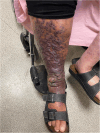Classical Kaposi sarcoma: an ınsight into demographic characteristics and survival outcomes
- PMID: 40229708
- PMCID: PMC11998273
- DOI: 10.1186/s12885-025-14085-0
Classical Kaposi sarcoma: an ınsight into demographic characteristics and survival outcomes
Abstract
Background: Classical Kaposi's sarcoma (CKS) is a rare angioproliferative disease associated with HHV-8, usually seen in the Mediterranean and Middle East regions. Knowing the subtypes, affected regions, and factors influencing prognosis is important for disease management.
Objective: To analyze the demographic characteristics, prognostic factors, treatment modalities, and survival of patients diagnosed with CKS.
Methods: Our center's records of patients diagnosed with CKS between January 2010 and December 2021 were retrospectively analyzed. Thirty-eight patients with histopathologically proven CKS were included in the study. Demographic and clinical characteristics of the patients, macroscopic, histopathologic, and immunohistochemical features of the lesions, treatments, and responses to treatment were evaluated. Kaplan-Meier survival curves were used to estimate survival outcomes, and log-rank test analyses were performed for intergroup comparisons.
Results: The median age at diagnosis of the patients was 71.0(39.0-93.0) years. Ten patients were female, and 28 were male. At the time of diagnosis, 63.2% of the patients had localised disease, nine patients were locally advanced, and five patients were metastatic. The tumor was most commonly localised in the lower extremity (65.8%), followed by the upper extremity. The median follow-up period was 69 (49-77.6) months. Local recurrence was detected in 24 patients during the follow-up. Median overall survival was not reached (NR) in localised disease(95% CI: 70.5-NR). In locally advanced disease, it was 31.1 months (95% CI: 13.8-63.0). In metastatic disease, it was 16.3 (95% CI: 12.6-20.0) months (p = 0.005).
Conclusion: This study emphasizes that CKS in our centre predominantly affects older males and typically manifests with nodular, early-stage lesions at the time of diagnosis. The majority of patients exhibited localised disease with no evidence of systemic involvement, while lymphedema was a frequent accompanying condition. Ulcerative manifestations were relatively uncommon, and survival outcomes varied significantly based on disease stage, with a marked decline in overall survival for patients with metastatic disease. The findings emphasize the importance of early diagnosis and the development of tailored treatment strategies to improve patient outcomes.
Keywords: Classical Kaposi sarcoma; Clinical forms; Kaposi sarcoma; Overall survival.
© 2025. The Author(s).
Conflict of interest statement
Declarations. Ethics approval and consent to participate: Approval for this study was granted by the Ankara University Faculty of Medicine Hospital on 10 June 2022, with the decision number E-32557014–604.01.02–543229. Written informed consent was obtained from all participants, and the study was planned and conducted according to the ethical principles outlined in the 1964 Declaration of Helsinki and its 2008 revision. Consent for publication: Not applicable. Competing interests: The authors declare no competing interests.
Figures
Similar articles
-
One hundred and five Kaposi sarcoma patients: a clinical study in Xinjiang, Northwest of China.J Eur Acad Dermatol Venereol. 2014 Nov;28(11):1545-52. doi: 10.1111/jdv.12349. Epub 2013 Dec 19. J Eur Acad Dermatol Venereol. 2014. PMID: 25350316
-
Classic Kaposi's sarcoma in Morocco: clinico-epidemiological study at the National Institute of Oncology.BMC Dermatol. 2011 Nov 11;11:15. doi: 10.1186/1471-5945-11-15. BMC Dermatol. 2011. PMID: 22078023 Free PMC article.
-
Classic Kaposi Sarcoma in the United States over the last two decades: a clinicopathologic and molecular study of 438 non-HIV-related Kaposi Sarcoma patients with comparison to HIV-related Kaposi Sarcoma.Mod Pathol. 2008 May;21(5):572-82. doi: 10.1038/modpathol.2008.15. Epub 2008 Mar 28. Mod Pathol. 2008. PMID: 18376387
-
Classic Kaposi sarcoma: Diagnostics, treatment modalities, and genetic implications - A review of the literature.Acta Oncol. 2024 Oct 16;63:783-790. doi: 10.2340/1651-226X.2024.40537. Acta Oncol. 2024. PMID: 39415564 Free PMC article. Review.
-
Update on classic Kaposi sarcoma therapy: new look at an old disease.Crit Rev Oncol Hematol. 2008 Dec;68(3):242-9. doi: 10.1016/j.critrevonc.2008.06.007. Epub 2008 Jul 25. Crit Rev Oncol Hematol. 2008. PMID: 18657433 Review.
References
-
- Kaposi. Idiopathisches multiples pigmentsarkom der Haut. Archiv für Dermatologie und Syphilis. 1872 ;4(2):265–273.
-
- Lanternier F, et al. Kaposi’s sarcoma in HIV-negative men having sex with men. AIDS. 2008;22(10):1163–8. - PubMed
-
- Ferlay J, et al. Global Cancer Observatory: Cancer Today (Version 1.1). Lyon, France: International Agency for Research on Cancer. 2024. Available from: https://www.gco.iarc.who.int/today. Accessed [DD Month YYYY]. [Google Scholar].
-
- Antman K, Chang Y. Kaposi’s Sarcoma. N Engl J Med. 2000;342(14):1027–38. - PubMed
-
- Yazici S, et al. Retrospective analysis of 91 kaposi’s sarcoma cases: a single-center experience and review of the literature. Dermatology. 2018;234(5–6):205–13. - PubMed
MeSH terms
LinkOut - more resources
Full Text Sources
Medical




